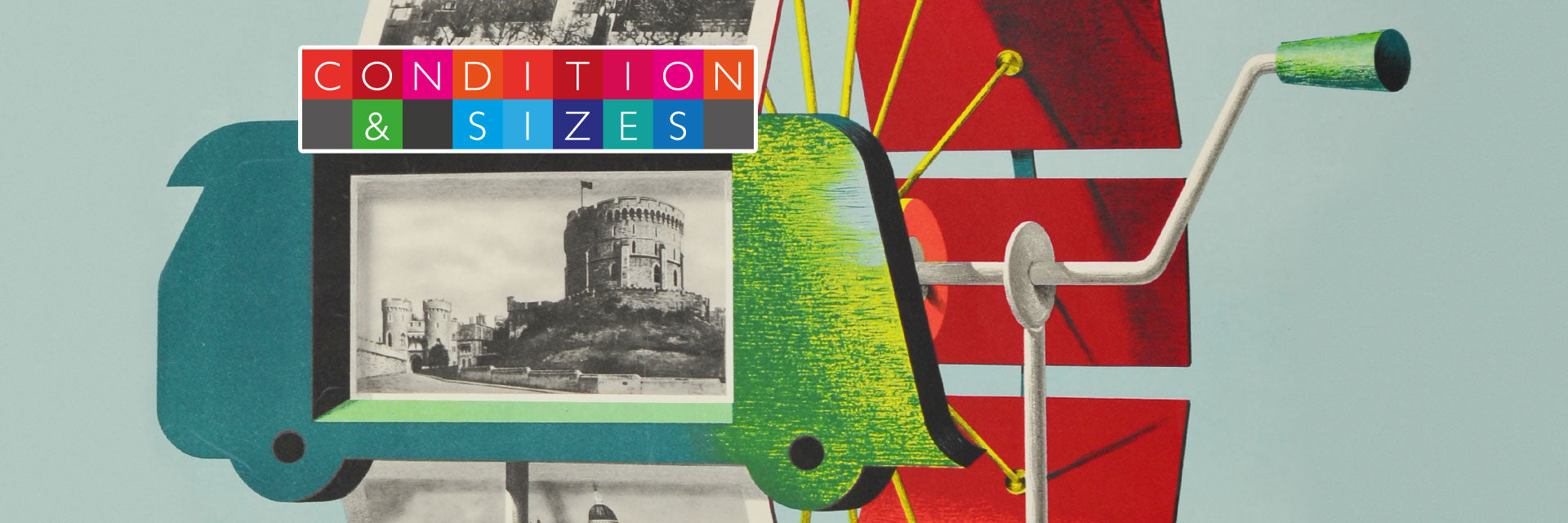Condition & sizes
As all of the items we sell are original, many will show some signs of age or use. Their survival to the present day has often been a matter of chance and it is rare to find an historic poster in pristine condition. Posters and ephemera were often printed on fairly low grade paper, designed to fulfil a specific function rather than last the test of time. All of which means that an authentic item is likely to have some imperfections, although we go to great lengths to secure good examples and routinely commission conservation work prior to listing.
Our condition grading system is intended to be as clear as possible, with items ranked A to C supported by high resolution images. Each grade has three further classifications, ranging from ‘minus’ to ‘plus’ (e.g. A-, A, A+). We will always draw attention to significant flaws and are happy to provide further information and/or images if required. The condition report will also indicate whether the item has been conserved (please see our section on ‘Conservation’ for more details).
Grading:
A Item is in excellent condition for age, with bright colour, no loss and minimal creasing or other imperfections.
B Item is in good condition for age. There may be small losses, pin holes and folds.
C Item is in poor condition, but not beyond restoration. Item may have fading, discolouration, significant loss or tears.
Sizes
Posters were printed in a variety of Imperial and Metric paper sizes, depending on the country of origin and date. For the purposes of this web site, the descriptive Imperial size is shown first (where appropriate) followed by the Metric measurement in millimetres. The principal Imperial paper sizes are:

[Reproduced from L. Richmond, The Technique of the Poster, 1933]
Double Crown (30 x 20 inches)
This format was used extensively in Britain by commercial advertisers and government agencies. It was also the unit of measurement for most larger posters found on the hoardings, which would be printed in multiples of the Double Crown format. Hence, a ‘4 Sheet’ poster would be the equivalent size of four Double Crown posters (i.e. 60 x 40 inches), while a ‘6 Sheet’ poster would equate to six Double Crown posters (i.e. 90 x 40 inches) etc.
Double Royal (40 x 25 inches)
This format was used almost exclusively by railway companies, including London Underground, and airlines.
Quad Royal (40 x 50 inches)
The larger version of the Double Royal, ideal of landscape images, used almost exclusively by railway companies and London Underground.
Other sizes
Odd and non-standard sizes were also used in Britain and elsewhere throughout the twentieth century, especially during wartime. ‘Strip posters’, for example, were produced during both world wars for recruitment and fundraising drives, often measuring 20 x 5 inches. Single Crown posters (15 x 20 inches) were also used as a wartime economy. At other times, poster sizes were specific to their intended use, such as the ‘panel posters’ printed for display in Tube carriages and on London tramcars.


